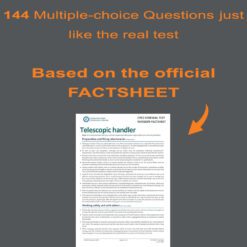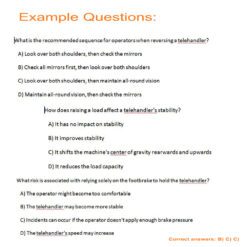RT17 CPCS Blue Card Renewal Mock Test with 144 Questions and Answers / A17 Telescopic Handler
£15.00 Original price was: £15.00.£9.95Current price is: £9.95.
Practice for your RT17 CPCS blue card renewal test with practice multiple choice questions – Just like the real NOCN/CPCS test!
- Questions & Answers: based on the latest RT 17 Telescopic Handler – CPCS Renewal Test Revision FACTSHEET
- Categories: A 17 – Telescopic Handler (Telehandler)
- Number of Multiple-choice Questions: 144
- Format: PDF
- Delivery time: Instant download after checkout
- Refunds: No refunds once downloaded, unless you ordered duplicates by mistake.
If there are any issues with your download, please email CardRenewalTest@gmail.com and we’ll send it ASAP
Ace Your CPCS Blue Card Renewal with Our RT17 Telescopic Handler Mock Practice Test
Why CPCS Blue Card Renewal Is Vital
Are you a Telescopic Handler operator looking to renew your CPCS blue card? We understand that staying up-to-date with the latest regulations and safety standards is crucial to your profession. Your CPCS blue card renewal ensures that you remain a competent and safe operator, ready to tackle any task with precision. But how can you ensure your renewal process goes smoothly?
The Challenge of CPCS Blue Card Renewal
Renewing your CPCS blue card isn’t just a formality; it’s a rigorous process that assesses your knowledge and skills. You’ll need to demonstrate that you’re well-versed in the latest safety guidelines, operational procedures, and industry best practices. It can be a daunting task, especially if you’re unsure of what to expect.
Subtitle 3: The Solution – RT17 Telescopic Handler CPCS Blue Card Renewal Mock Practice Test
Our RT17 Telescopic Handler CPCS Blue Card Renewal Mock Practice Test is your perfect preparation tool. Designed to mirror the real CPCS renewal test, this mock test covers all the essential topics and challenges you’ll face. Here’s why you need it:
1. Familiarize Yourself with the Latest NOCN CPCS RT17 Factsheet
Our mock practice test is based on the most recent NOCN CPCS RT17 Telescopic Handler factsheet. It ensures that you’re studying the most up-to-date materials, helping you feel confident and prepared.
2. Get a Glimpse of the Real Test Environment
Walking into the CPCS renewal test room can be nerve-wracking. Our mock test replicates the test environment, complete with multiple-choice questions just like the real thing. This helps you feel more at ease during the actual test.
3. Test Your Knowledge and Identify Knowledge Gaps
The mock test assesses your understanding of crucial Telescopic Handler operating concepts. It’s an opportunity to evaluate your knowledge and identify areas where you might need additional study or practice.
4. Boost Your Confidence and Reduce Anxiety
Studying and taking practice tests are the best ways to reduce test anxiety. By practicing with our mock test, you’ll boost your confidence and increase your chances of passing the real CPCS renewal test.
5. Convenient and Accessible
Our mock test is available online, making it convenient for you to study anytime, anywhere. No need to schedule appointments or travel to a testing center.
6. Ace Your CPCS Blue Card Renewal
The RT17 Telescopic Handler CPCS Blue Card Renewal Mock Practice Test is your key to success. Whether you’re a seasoned operator or just starting your career, this test is a valuable resource to help you secure your blue card renewal.
Your CPCS Blue Card Renewal Journey Starts Here
Don’t leave your CPCS blue card renewal to chance. Prepare with confidence and ensure that you’re ready for the challenges that lie ahead. With our RT17 Telescopic Handler CPCS Blue Card Renewal Mock Practice Test, you’ll be well-equipped to demonstrate your competence and secure your card renewal.
Renew your CPCS blue card with ease and stay ahead in your Telescopic Handler operator career. Get started with our mock practice test and take the first step towards a successful renewal.
Here’s a summary of the key learning points from the official RT17 Telescopic Handler factsheet:
Preparation and Fitting Attachments
- Telescopic handlers, also known as telehandlers, are commonly used in construction, agriculture, and allied sectors for lifting, carrying, and placing loads at height and reach.
- Operators must conduct thorough pre-use checks following manufacturers’ requirements, which can be found in the operator’s manual.
- Forks are prone to wear, particularly at the heel or back end, and wear should be measured against manufacturer specifications.
- Any faults or defects noticed by the operator should be reported immediately, and the telehandler should be taken out of service.
- Operating a machine with defects, even seemingly minor ones, can be hazardous and should be avoided.
- Different-sized front tires can lead to instability, especially when picking and placing loads at height.
- Load charts relevant to attachments must be available for the operator to use.
- In cases where a specific load chart doesn’t exist, the weight of the attachment should be known and deducted from the lifting capacity.
- Operators must be trained in fitting and using attachments and must visually and physically check that all locking pins are correctly fitted and secure.
Working Safely and With Others
- Telehandler operations often occur in congested and confined areas, and operators should be aware of their surroundings.
- Collisions with pedestrians are a significant part of forklift-related incidents, so segregated walkways should be provided where pedestrians share routes with telehandlers.
- Reversing a telehandler can be hazardous due to limited visibility, so operators must ensure a clear path.
- Operators should check all mirrors, look over both shoulders, and maintain all-round vision while reversing.
- Adequate visibility is essential when placing loads at height, and assistance should be used when conditions reduce visibility.
- Telehandlers should be driven at an appropriate speed for the conditions, allowing operators to react to situations.
- Braking sharply can lead to load sliding from the forks.
- Telehandlers should be kept well clear of overhead power lines to prevent the risk of arcing.
- Leaving the operator’s seat for adjustments requires applying the handbrake and switching off the engine.
- Unintended machine movement can occur if a transmission or operating lever is inadvertently knocked into drive when the operator exits the seat.
Stability
- Telehandler overturning is a common occurrence due to various reasons, and operators must understand conditions causing instability both longitudinally and laterally.
- Operators must check the manufacturer’s maximum rated capacity, lifting capacity relative to height and reach, and load center before carrying any load.
- If a load’s center of gravity exceeds the machine’s load center, the carrying capacity must be reduced.
- Longitudinal stability relies on the counterbalance effect, which can be reduced by increasing the weight on the forks or extending the boom.
- Carrying a load downhill on a slope can risk tipping forward, affecting longitudinal stability.
- Raising a load affects stability, with higher loads and sideways lifting increasing the risk of tipping.
- No loads should be lifted unless the telehandler is level and the ground is firm.
- Using stabilizers can prevent sinking into soft ground and improve stability.
- Travelling with a raised boom increases instability, especially on uneven ground and while turning.
- When placing loads at height, the telehandler must be on firm, level ground and facing the placement point.
- Traveling on slopes requires careful consideration of gradient and direction based on whether the machine is laden or unladen.
- Load charts indicate the maximum load that can be safely lifted to a given height and reach.
Lifting Loads and Using Attachments
- Operators must know the weight of the load, the safe lifting height, and reach, provided by load capacity charts.
- Estimating load weight based on size, height, width, and length alone is unreliable.
- Operators must judge the load center and compare it to the telehandler’s load center as indicated in the load charts.
- The load center is typically 500mm from the face of the forks, but some are rated at 600mm.
- Front-mounted stabilizers on higher-capacity telehandlers improve forward stability.
- Load charts differ for stabilizer use and non-stabilizer use, and operators should ensure they use the correct chart.
- When using stabilizers, the ground must be firm to prevent sinking, which can cause instability.
- Load moment indicators provide visual and audible warnings when the machine approaches or exceeds safe limits during lifting.
- These indicators do not indicate whether it is safe to lift and place a load or the load’s weight.
Carrying and Traveling with Suspended Load
- Proper planning by a competent person (lift planner) is essential when carrying and traveling with suspended loads.
- This requires setting up the forklift according to manufacturer’s instructions.
- Traveling with suspended loads can restrict forward vision, requiring measures such as traveling in reverse with assistance.
- Load swing or external factors like wind can cause instability, so operators must take precautions.
- Load handlers or slinger/signalers are at risk of being struck by the moving machine, and safe systems of work must be devised.
These points provide a comprehensive overview of the key considerations and safety practices for operating telescopic handlers (telehandlers) safely and efficiently.
7 reviews for RT17 CPCS Blue Card Renewal Mock Test with 144 Questions and Answers / A17 Telescopic Handler
Add a review Cancel reply
Related products
CPCS Blue Card Renewal Tests
CPCS Blue Card Renewal Tests
RT65 CPCS Blue Card Renewal Mock Test with 133 Questions and Answers / A65 Demolition Plant
CPCS Blue Card Renewal Tests
CPCS Blue Card Renewal Tests
RT37 CPCS Blue Card Renewal Mock Test with 122 Questions and Answers / A37 Trencher
CPCS Blue Card Renewal Tests
RT66 CPCS Blue Card Renewal Mock Test with 133 Questions and Answers / A66 Compact Crane
CPCS Blue Card Renewal Tests
RT45 CPCS Blue Card Renewal Mock Test with 110 Questions and Answers / A 45,46,47,48 Piling Rig
CPCS Blue Card Renewal Tests
CPCS Blue Card Renewal Tests
RT30 CPCS Blue Card Renewal Mock Test with 113 Questions and Answers / A30 Piling Rig Tripod

















Costa –
I pass this first time the people at center say one question wrong
Olivia –
I recommend. Good practice questions from the telehandler factsheet
George –
Man Ive been looking for something like this. I bought some other tests before but it was total rubbish. This one comes quite close to the Telehandler renewal test. Obvi it’s not the exact questions and answers but gives a good idea and most importantly tested my knowledge before going to the exam. Def worth the buy
Ionut –
Thank you. This help me
John –
Easy to read, Highly recommended to anyone taking the telehandler renewal.
Carter –
Brilliant idea mate! This is very useful practice before the forks test 👏
Joseph Dixon –
I was a bit hesitant but for this price I though that you can’t really go wrong.
I downloaded the pdf and could study from it instantly which is nice. The questions and answers were very similar to the telehandler renewal test. All in all great purchase and I recommend it to anyone taking this test. 👏